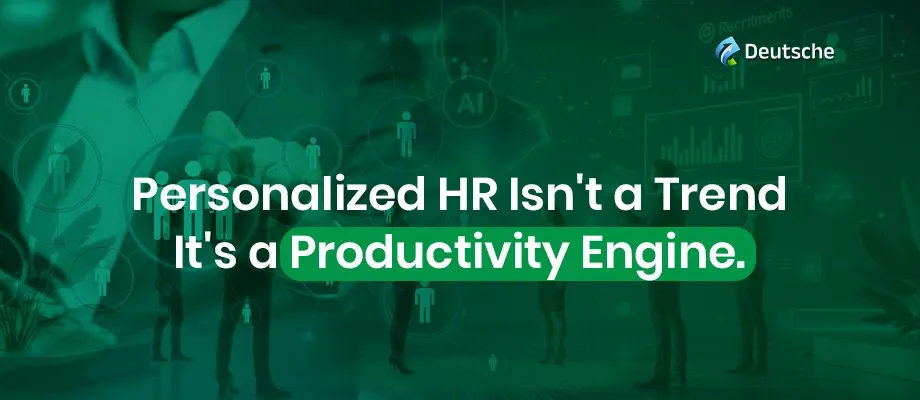The Power of One – How Leading Companies Boosted Productivity by 35% with Personalized HR
Human resources is going through a quiet revolution as policies establishing standardised parameters for how people work, learn, and develop are being set aside. Today, visionary organizations are embracing hyper-personalized employee experiences, receiving staggering results with some firms experiencing a 35% uplift in workforce productivity.
The foundation of this transformation rests on a simple notion: people perform better when viewed as individuals and not numbers. With the rise of Artificial Intelligence (AI) and people analytics, organizations now consider customization for everything from learning programs to benefit plans in response to each worker's defined goals, capacities, and lifestyles. The results are higher engagement, happier workers, and better business performance.
From Programs to People: The Rise of Personalized HR
For numerous years, HR systems were built with an emphasis on efficiency, as opposed to employee individuality or personalization. The employee experience, processes and policies were the same for everyone. It has changed in a time when employees from five generations now work together.
Personalized HR flips that idea around. It shifts the focus from managing a number of employees to empowering each individual to achieve their fullest potential.
"That 35% increase in productivity isn't a coincidence; it is the power of true employee empowerment," states Dr. Elena Rodriguez, Chief People Scientist, Future of Work Institute. "You remove friction and provide genuine intrinsic motivation when HR recognizes a Gen Z hire receives great pleasure from mobile-first, micro learning, where a more experienced leader possesses flexible hybrid options and customized leadership training options."
This shift is data-driven, through the lens of engagement feedback, performance reviews, skills assessment, and even communication preferences. Those are combined to build an Employee Value Proposition (EVP) that is fluid and adaptive when it comes to the individual, not against the individual.
Case study: Innovatech
Global technology company Innovatech found itself facing the same issue again: in a quickly changing industry, the race to get employees' skills up to date was never-ending. Traditional training was not working — engagement had already dropped, and completion rates were low. The answer was to implement an AI-enabled Learning Management System (LMS), which connected training to an employee's skill gaps and career goals.
The system reviewed the data to establish the exact training areas each employee needed to better themselves in. It also provided short, individual lessons; for instance, one engineer attended a two-day workshop on becoming a better leader, and another took a coding course that lasted 15 minutes. Integrated coaching bots provided individual suggestions on the next step.
The result was encouraging: Innovatech experienced a 28% uptick in learning and development engagement scores and a 45% reduction in new skills time-to-competency in 18 months. Employees became more self-assured and innovative as they progressed in knowledge.
Case study: Apex Bank
Apex Bank was experiencing elevated turnover in middle management. Surveys indicated there was stress, burnout, and a legacy inflexible benefits programme. Apex implemented an AI-powered flexible benefits platform, allowing employees more choice and control.
The system provided tailored benefits recommendations through comprehension of wellness data, demographics, and preferences. Parents focused on childcare and mental health benefits, while younger employees favoured fitness credits and tuition reimbursement. Employees have the option to change their benefits at their convenience through a modern, mobile-first portal, repositioning HR as the facilitator rather than the participant.
The results were remarkable: management morale increased, reported employee burnout dropped 15 percent, and voluntary turnover dropped 24 percent. Employees felt like their opinions mattered, were motivated, and empowered to establish their own balance.
Personalised HR is guided by data and ethical AI — not well-meaning good intent. People analytics takes performance trends and learning behaviours, for example, and changes unstructured data into comprehensible insights about employees. From a chatbot helping to onboard new employees to an algorithm matching them with the HR specialist best suited for them, AI and machine learning take the human guesswork out of customised recommendations.
In fact, technology is making human resources more human rather than less human when in a physical working space. As Dr. Rodriguez stated, "The idea that technology is making HR cold is outdated." "In fact, it frees HR people up to focus on humans - to have meaningful, deep conversations on what each employee actually cares about."
The data speaks for itself. Organizations implementing tailored HR strategies see measurable improvements in engagement, productivity, and retention. The takeaway for organizations looking ahead is simple: the old ways of HR will likely be over. Organizations that appreciate the potential of one and put it to work will hold the future.
